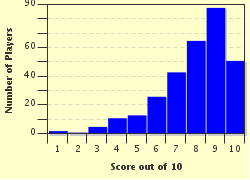Quiz Answer Key and Fun Facts
1. When did Hitler first order that top priority be given to rearmament?
2. In 1936 Hitler committed a spectacular violation of the Versailles Treaty. Which of these was it?
3. In March 1938 Germany annexed Austria, and in September 1938 Germany demanded that the Sudetenland be handed over by October. What name is given to the British and French policy of acceptance of this expansion?
4. When did Adolf Hitler launch the invasion on Poland?
5. This famous battle was a disaster for Germany and a great success for Britain. What was it?
6. Having failed to conquer Britain, Hitler turned his attention on another country. He launched Operation Barbarossa. What nation was the target?
7. This event brought the United States of America into WWII. Where did it take place and which country was responsible for it?
8. This battle was the bloodiest in World War II. It is also regarded as a key turning point in the war on the Eastern Front. Where was it and who surrendered to the Soviets?
9. D-Day was launched on the 6th of June 1944. The Allies would target five beach zones along the coast of Normandy, France. Name the beach zones targeted by the United States.
10. These two events ended the war in Europe and in the Pacific, respectively. What were they?
Source: Author
WW2Master123
This quiz was reviewed by FunTrivia editor
bloomsby before going online.
Any errors found in FunTrivia content are routinely corrected through our feedback system.


